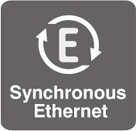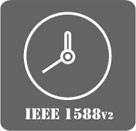
Design Innovation
Selected Ethernet Direct switches now supports the latest technology features making it possible to address any given application requirements for added safety and security.
|
|
 |
Synchronous Ethernet, is an ITU-T standard for computer networking that facilitates the transference of clock signals over the Ethernet physical layer. The Synchronous Ethernet signal transmitted over the Ethernet physical layer should be traceable to an external clock, ideally a master and unique clock for the whole network. |
|
|
 |
Precision Time Protocol (PTP) is a protocol used to synchronize clocks throughout a computer network. On a local area network, it achieves clock accuracy in the sub-microsecond range, making it suitable for measurement and control systems. |
|
|
 |
Generic Object Oriented Substation Events (GOOSE) is a controlled model mechanism in which any format of data is grouped into a data set and transmitted within a time period of 4 millisecond. The following mechanisms are used to ensure specified transmission speed and reliability. For mission-critical applications, GOOSE messages can be placed into the highest QoS priority to avoid packet loss and delay. |
|
|
 |
Power over Ethernet (PoE) new standards supported:
|
In an industrial application, the failure recovery time is extremely critical to network quality and reliability. Ethernet Direct has developed our proprietary redundancy protocol to better improve the failure recovery time. We provide the most cost-effective solution that supports flexible and scalable network topologies and has a much shorter failure recovery time than any other spanning tree protocols.
Ethernet Direct offers three types of proprietary redundancy protocols namely:
|
|
 |
Direct-Ring is a powerful ring protocol which can support up to 5 separate redundant ring configurations and are able to operate independently from the other rings. Each ring supports 250 units of switches to offer a scalable network infrastructure. In case of any network disruption, recovery is secured in less than 10 milliseconds. |
|
|
 |
Direct-Ring redundancy protocol can also work with other devices owing to our software design capabilities. When using a non Direct-ring device in a ring, the Direct-Chain feature is supported to make the enable the network. Direct-Chain supports 250 units in a ring. Both Direct-Ring and Direct-Chan can be used in a closed or open ring topology. |
|
|
 |
Join-Ring redundant topology is to be used with either Direct-Ring or Direct-Chain and allows a maximum of 250 devices. Join-Ring allows engineer to have more flexibility in planning the network even with complex ring configurations. |
The design concepts of Direct-Ring, Direct-Chain and Join-Ring is to provide end-users with more freedom to establish any kinds of network topologies no matter how simple or complex they are. The added flexibility and scalability can help control engineers to plan and expand the network with easy management, easy maintenance and low cost of ownership.
More details is available upon request in the Ethernet Direct Ring Redundancy White Paper.